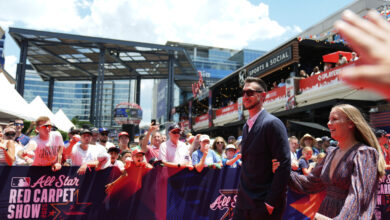
Craig Kimbrel Might Finally Add Long-Awaited Changeup to Mix
Sometimes the jokes write themselves, like when several tweets about Craig Kimbrel giving up a two-run homer to Willson Contreras in Tuesday’s scrimmage prompted a slew of “midseason form” replies. I’ll admit to participating, but it’s only fair to note that it was the closer’s first live action in over three months and he was more concerned with command than getting outs.
That ball is gone!
Willson hits one out & provides a glimpse of what home runs in 2020 sound like. pic.twitter.com/5iwzFP99y4
— Marquee Sports Network (@WatchMarquee) July 8, 2020
Though Kimbrel gave up two hits, the dinger and a leadoff single by Kris Bryant, MLB.com’s Jordan Bastian noted that he threw 15 of 19 pitches for strikes. If the continuation of his propensity for allowing hits and homers at an alarming rate has you a little concerned, maybe it’s best to focus on the potential for those 5.23 walks per 9 innings to come way down.
As overly simplistic as it sounds, just throwing more strikes should yield a great deal of improvement in Kimbrel’s results. Getting behind and then having to throw your fastball for strikes is one thing, but you can get tagged when your velocity is down and you’re grooving more pitches. The bearded reliever’s 96.4 mph average four-seam last year was down more than one tick from 2018 and more than two from 2017, shaving precious surplus from his margin for error.
Kimbrel grooved nearly 7.2% of his fastball’s last season, his highest percentage since 2012, as he battled through rust and resultant physical maladies. Elite track record or no, big league hitters are going to jump all over a straight fastball. David Ross doesn’t seem to be concerned, though, dismissing last year as an aberration.
“He was throwing breaking balls for strikes with ease the other day in the bullpen,” Ross said. “The ball was jumping out. Good ride on it. All the numbers we’re getting back from the analytical group and the data we’re receiving from these [bullpen sessions] and these live sessions have been great. The pitching staff looks really, really good.”
Okay, I can sense that a few of you are still skeptical and I totally get it. After all, giving up nine homers in just 20.2 innings last season is pretty scary. Add in the three taters hitters have baked against Kimbrel over just 3.2 exhibition innings this year and there’s little evidence to support a turnaround.
Unless Kimbrel can make a tweak to produce meaningful improvement, maybe an adjustment to make the fastball play up. Enter the changeup. Mark Gonzales of the Chicago Tribune tweeted that Kimbrel has been working on the offspeed pitch and even incorporated feedback from Rapsodo equipment while throwing at home during the shutdown.
Kimbrel says he’s continuing to work on change up, used Rapsodo equipment while throwing at home
— Mark Gonzales (@MDGonzales) July 8, 2020
At the risk of creating undue hype for something that is clearly a work in progress, this could be a big freaking deal. I mean, Kimbrel doesn’t throw changeups. Like ever. Out of the roughly 9,300 pitches he’s thrown in MLB action, only four have ever been classified as changeups. That’s 0.00043% of his career pitches, easily a small enough number to be chalked up to error.
Except this isn’t the first time we’ve heard about Kimbrel tinkering with a changeup. Early in 2015 spring training, when Kimbrel was with the Braves, David O’Brien of the Atlanta Journal-Constitution reported that he was throwing the offspeed pitch in live BP. O’Brien wrote that expanded his repertoire “might seem like cruel and unusual punishment for hitters,” though then-manager Fredi Gonzalez was more practical.
“He’s probably just playing with it,” Gonzalez said. “Add a third pitch if he has to. I don’t know how much he’ll use it when the games start.”
Sure enough, Kimbrel threw the change just twice in 2015…for the Padres. In what was a shocking move at the time, he was traded to San Diego just two hours before the Cubs and Cardinals opened the season with that infamous Sunday night game at Wrigley in which Solo cups became port-a-potties. Fast-forward five years and getting back to the changeup could key Kimbrel’s resurgence.
It doesn’t even need to become a go-to pitch, but being able to mix it in just once in a while would keep hitters from sitting on the fastball. And when it’s the last thing a hitter is expecting, the pitch doesn’t even need to be particularly great because the velocity difference alone is going to have them out front.
Can you imagine how many hitters would be fooled if they’re sitting dead red and then end up getting a floater in the mid-80’s? In addition to getting some hilariously bad swings, adding the new wrinkle might be necessary. While it’s possible the extended time off and more regimented prep work will have the 32-year-old back to throwing 98 with rise, it might not be wise to count on the fastball/curveball combo alone moving forward.
Something has to change, and maybe it will.

